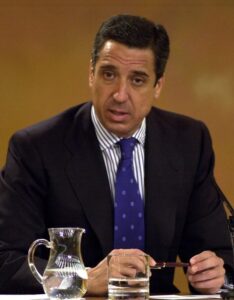Explore about the Famous Politician Ron Johnson, who was born in United States on April 8, 1955. Analyze Ron Johnson’s net worth, age, bio, birthday, dating, height-weight, wiki. Investigate who is Ron Johnson dating now? Look into this article to know how old is Ron Johnson?
Ron Johnson Birthday Countdown
Ron Johnson Biography
Tea Party politician who became a U.S. Senator from Wisconsin in 2011 after serving as the chief executive officer of a polyester and plastics manufacturer.
He graduated from the University of Minnesota before working as an accountant for Jostens, an American company that provided yearbooks and class rings for high schools and colleges.
He was criticized by victims’ rights groups in 2010 when he opposed a Wisconsin bill that would have eliminated the time limit for future child sex abuse victims to bring lawsuits.
He had three children with his wife Jane.
He began serving with Tammy Baldwin in the Senate after she was elected in 2013.
Ron Johnson (born October 15, 1959) is the former chief executive officer of J. C. Penney. Previously, he was the senior vice president of retail operations at Apple Inc., where he pioneered the concept of the Apple Retail Stores and the Genius Bar, and the vice president of merchandising for Target Corporation, where he was credited for making the store appeal to a younger and trendy crowd.” He is currently the head of Enjoy, a startup company and he serves on the Board of Directors for Globality Inc., a start-up company based in Menlo Park, CA.
Johnson joined Apple Inc. as senior vice president of retail operations in January 2000. At the suggestion of Millard Drexler (an Apple director and CEO of Gap Inc.), Johnson’s retail team and a development team headed by Allen Moyer from The Walt Disney Company began a series of mock-ups for the Apple store in a warehouse near the company’s headquarters in Cupertino.
On October 31, 2007, Johnson exercised 700,000 stock options in Apple shares, with a strike price of $23.72, and then sold the stock later that day for $185 to $185.21 apiece, netting him a $112 million profit. It was reported that Johnson earned $400 million during his seven and a half years at Apple.
After his success at Apple and Target, Johnson was hired as chief executive officer by J. C. Penney in November 2011, succeeding Mike Ullman, who had served as CEO for the preceding seven years. Ullman then served as chairman of the board of directors, but was relieved of his duties in January 2013. Bill Ackman, a J. C. Penney board member and head of hedge fund Pershing Square supported bringing in Johnson to shake up the store’s stodgy image and attract new customers. Johnson was given $52.7 million when he joined J. C. Penney, and he made a $50 million personal investment in the company. After being hired, Johnson tapped Michael Kramer, an Apple Store veteran, as chief operating officer while firing many existing J.C. Penney executives.
When Johnson announced his transformation vision in late January 2012, J. C. Penney’s stock rose 24 percent to $43. Johnson’s actual execution, however, was described as “one of the most aggressively unsuccessful tenures in retail history”. While his rebranding effort was ambitious, he was said to have “had no idea about allocating and conserving resources and core customers. He made promises neither his stores nor his cash flows would allow him to keep”. Similar to what he had done at Apple, Johnson did not consider a staged roll-out, instead he “immediately rejected everything existing customers believed about the chain and stuffed it in their faces” with the first major TV ad campaign under his watch. Johnson defended his strategy, saying that “testing would have been impossible because the company needed quick results and that if he hadn’t taken a strong stance against discounting, he would not have been able to get new, stylish brands on board.”
Under Johnson’s leadership, Apple’s retail stores achieved a record level of growth, exceeding a billion dollars in annual sales within two years of their debut, surpassing the previous record set by the Gap clothing retailer. In 2012, Apple operated more than 400 stores, with outlets in Australia, Canada, China, France, Germany, Italy, Switzerland, United Kingdom, United States, Hong Kong and Japan. According to Fortune “Saks, whose flagship store is down the street, generates sales of $362 per square foot a year. Best Buy stores turn $930 – tops for electronics retailers – while Tiffany & Co. takes in $2,666. Audrey Hepburn liked Tiffany’s for breakfast, but at $4,032 per square foot, Apple is eating everyone’s lunch”. In 2011m Apple Stores in the United States had revenue of $473,000 per employee. According to the research firm RetailSails, the Apple Store chain ranked first among U.S. retailers in terms of sales per unit area in 2011, with sales of US$3,085 per square foot, almost double that of Tiffany & Co., the second retailer on the list.
Throughout 2012, sales continued to sag dramatically. In the fourth quarter of the 2012 fiscal year, same-store sales dropped 32%, which led some to call it “the worst quarter in retail history.” On April 8, 2013, he was fired as the CEO of J. C. Penney and replaced by his predecessor, Mike Ullman.
In 2014, Johnson founded Enjoy, a startup headquartered in Palo Alto, California, that seeks to reinvent the shopping experience. The company has raised $30 million in funding, co-led by Kleiner Perkins Caufield Byers and Oak Investment Partners with participation from Andreessen Horowitz. Johnson also committed personal capital to establish the company. The service launched in 2015.
As of 2015, Johnson lives in Atherton, California.
Many of the initiatives that were successful at the Apple Stores, for instance the “thought that people would show up in stores because they were fun places to hang out, and that they would buy things listed at full-but-fair price” did not work for the J.C. Penney brand and ended up alienating its customers who were used to heavy discounting. By eliminating the thrill of pursuing markdowns, the “fair and square every day” pricing strategy disenfranchised JC Penney’s traditional customer base. Johnson himself was said “to have a disdain for JC Penney’s traditional customer base.” When shoppers weren’t reacting positively to the disappearance of coupons and sales, Johnson didn’t blame the new policies. Instead, he offered the assessment that customers needed to be “educated” as to how the new pricing strategy worked. He also likened the coupons beloved by so many core shoppers as drugs that customers needed to be weaned off.” While head of J. C. Penney, Johnson continued to live in California and commuted to work in Plano, Texas by private jet several days a week.
What's Ron Johnson Net Worth 2024
| Net Worth (2024) | $1 Million (Approx.) |
| Net Worth (2023) | Under Review |
| Net Worth (2022) | Under Review |
| Net Worth (2021) | Under Review |
| Net Worth (2020) | Under Review |
Ron Johnson Family
| Father's Name | Not Available |
| Mother's Name | Not Available |
| Siblings | Not Available |
| Spouse | Not Available |
| Childrens | Not Available |






